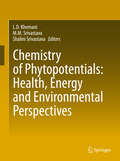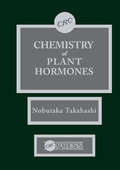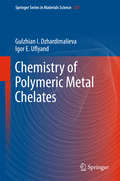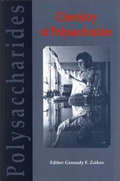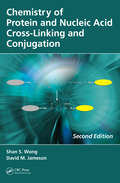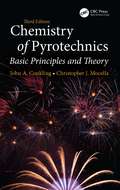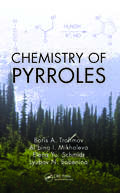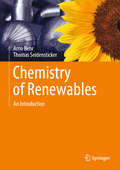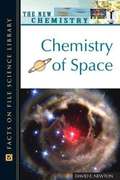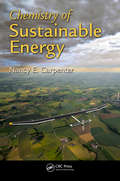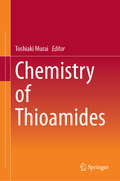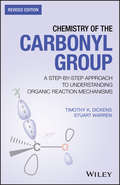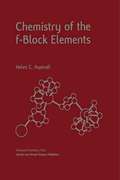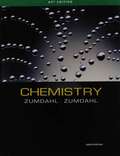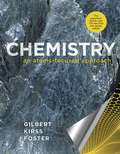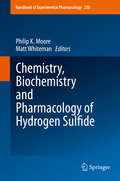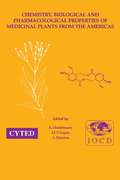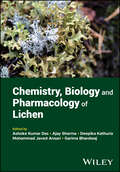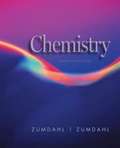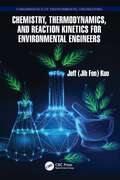- Table View
- List View
Chemistry of Phytopotentials: Health, Energy And Environmental Perspectives
by Shalini Srivastava Ld Khemani Mm SrivastavaSince the beginning of human civilization, plants have been our true companions. Plants contribute not only to our existence but also serve us through discovery, design and the treatment of various diseases where there is no satisfactory cure in modern medicine. This has focused Natural Product Chemists to unravel plants therapeutic potential in the light of modern analytical and pharmacological understandings. Presence of multiple active phytochemicals in medicinal plants offers exciting opportunity for the development of novel therapeutics, providing scientific justification for their use in traditional medicines. Non-food plants have been recognized as biofactories for the production of eco-friendly value added materials including agricultural, food products, enzymes, nutraceuticals etc. They have also been widely explored for personal care, industrial products and sources of energy generation. The proven efficacy of botanicals has been appreciated by the scientific community and strengthened plant-human relationship. The synergism in the Phytoproducts, the result of the interaction of two or more moieties, is not simply additive but multiplicative. Recent acceptance of the Food and Drug Administration (US) for herbal-medicine based preparation has renewed interest in Natural Product Research. The year 2011 is declared as the International Year of Chemistry (IYC 2011) by the United Nations Assembly. On this occasion, the present conference CPHEE 2011 aims to offer chemists from diverse areas to come to a common platform to share the knowledge and unveil the chemistry and magic potentials of phytoproducts for the mankind.
Chemistry of Plant Hormones
by Nobutaka TakahashiThe chemistry of the five principal plant hormone groups is discussed in detail in this volume. Contributing authors review history and occurrence of each hormone group, methods of isolation and detection, biosynthesis and metabolism, and structural determination. Through these analyses, the authors clarify the role of endogenous plant growth regulators in the life cycle of higher plants. The text is supplemented with over 350 figures and structures of various plant hormones.
Chemistry of Polymeric Metal Chelates
by Gulzhian I. Dzhardimalieva Igor E. UflyandThis book deals with the chemistry of polymeric metal chelates. The main results and the production and chemical structure of polymers with chelate units as well as the specificity of metal complex binding of different structure are presented here. This book also reveals the transformations which components undergo in the course of chelation. Special attention is paid not only to synthetic but also to natural (including living) systems. The usage of polymeric metal chelates and their development are examined. The related research was performed for chelates with chain structure. This book is useful to researchers being active in synthesis and design of macromolecular metal chelates
Chemistry of Polysaccharides
by Gennady E. ZaikovThis monograph summarizes scientific achievements in the field of polysaccharide chemistry performed in the last decade. The book is intended for wide range of readers: students, post graduates, engineers and scientists engaged in polymer chemistry, organic and physical chemistry.
Chemistry of Protein and Nucleic Acid Cross-Linking and Conjugation
by Shan S. Wong David M. JamesonSince the publication of the first edition of Chemistry of Protein Conjugation and Cross-Linking in 1991, new cross-linking reagents, notably multifunctional cross-linkers, have been developed and synthesized. The completion of the human genome project has opened a new area for studying nucleic acid and protein interactions using nucleic acid cross
Chemistry of Pyrotechnics: Basic Principles and Theory, Third Edition
by Chris Mocella John A. ConklingThis book provides chemists with technical insight on pyrotechnics and explosives. It emphasizes basic chemical principles and practical, hands-on knowledge in the preparation of energetic materials. It examines the interactions between and adaptations of pyrotechnics to changing technology in areas such as obscuration science and low-signature flame emission. The updated third edition discusses chemical and pyrotechnic principles, components of high-energy materials, elements of ignition, propagation, and sensitivity. It offers heat compositions, including ignition mixes, delays, thermites, and propellants and investigates the production of smoke and sound as well as light and color.
Chemistry of Pyrroles
by Boris A. Trofimov Al'bina I. Mikhaleva Elena Yu Schmidt Lyubov N. SobeninaDuring the last 30 years, knowledge of the essential role that pyrrole structures play in the chemistry of living organisms, drug design, and the development of advanced materials has increased. Correspondingly, research on the diverse issues of synthetic, theoretical, and applied chemistry has snowballed. Devoted to the latest achievements of this
Chemistry of Renewables: An Introduction
by Arno Behr Thomas SeidenstickerThis textbook introduces the industrial production and processing of natural resources. It is divided into six major topics (fats and oils, carbohydrates, lignin, terpenoids, other natural products, biorefinery), which are divided into a total of 20 chapters.Each chapter is self-contained and therefore a compact learning unit, which can be worked on by students in self-study or presented by lecturers. Clear illustrations, flow diagrams, apparatus drawings and photos facilitate the understanding of the subject matter. All chapters end with a succinct summary, the "Take Home Messages". Each chapter is supplemented by ten short test questions, which can be solved quickly after working through the chapter; the answers are at the end of the book. All chapters contain bibliographical references that focus on essential textbooks and reference works. As a prior knowledge, only basic knowledge of chemistry is required.
Chemistry of Space
by David E. NewtonChemistry of Space provides an overview of the latest information about the solar system, comets, and meteors, and other features of the universe made available as a result of space exploration and research in astrochemistry. The volume is an impressive account of our universe, the events through which it was created, the changes that have taken place during its evolution, and its present composition.
Chemistry of Sustainable Energy
by Nancy E. CarpenterUnderstanding the chemistry underlying sustainable energy is central to any long-term solution to meeting our future energy needs. Chemistry of Sustainable Energy presents chemistry through the lens of several sustainable energy options, demonstrating the breadth and depth of research being carried out to address issues of sustainability and the gl
Chemistry of Thioamides
by Toshiaki MuraiThis book covers whole aspects of the sulfur isologues of amides. Starting from the synthetic methods of thioamides, a range of synthetic applications to the construction of carbon–sulfur and carbon–carbon bonds, to asymmetric reactions, to formation of heterocycles are described. Among the array of thiocarbonyl compounds, thioamides are readily handled in room temperature air. Some of their characteristic features are that the polarity of C=S bonds in thioamides is much smaller than C=O bonds in ordinary amides, that thioamides possess higher HOMO and lower LUMO when compared with those of ordinary amides, and that carbon atoms alpha to the C=S and nitrogen atoms in thioamides are more acidic than those in ordinary amides. Theoretical studies further disclose their features. Thioamides are also used as ligands to a wide variety of metals. Their unique photophysical properties and catalytic activities are described here. Characteristic features of biologically relevant thioamides, e.g., thiopeptides and related compounds, are the final focus of the book.
Chemistry of the Carbonyl Group: A Step-by-Step Approach to Understanding Organic Reaction Mechanisms
by Stuart Warren Timothy K. DickensTeaches and enables students to build confidence in drawing and manipulating curly arrows, a fundamental skill for all organic chemists This book is an interactive approach to learning about chemistry of the carbonyl group—inviting students to work through its pages with pencil and paper in hand. It educates with the belief that the most effective way to learn is by practice and interaction. With this in mind, the reader is asked to predict what would happen under a specific set of reaction conditions. The book is divided into frames: each frame poses a question and invites the reader to predict what will happen. Subsequent frames give the solution but then pose more questions to develop a theme further. Chemistry of the Carbonyl Group: A Programmed Approach to Organic Reaction Mechanisms, Revised Edition provides a solid grounding in the fundamental reactions of carbonyls. Presented in full colour to enhance the understanding of mechanisms within chemistry, the chapters of this step-by-step guide cover: nucleophilic addition to the carbonyl group; nucleophilic substitution; nucleophilic substitution at the carbonyl group with complete removal of carbonyl oxygen; carbanions and enolisation; and building organic molecules from carbonyl compounds. A must-have book for undergraduate chemists to emphasise understanding in carbonyl group chemistry Goes through all the stages of basic carbonyl chemistry, detailing even the simplest mechanisms A step-by-step learning guide to synthetic chemistry for the first year of a chemistry degree, with all the information needed for independent learning Provides a solid grounding in the fundamental reactions of carbonyls which will inform the understanding of many other organic chemistry reactions Chemistry of the Carbonyl Group: A Programmed Approach to Organic Reaction Mechanisms - Revised Edition is packed with all the information on synthetic chemistry that every first-year student will need in order to learn independently.
Chemistry of the f-Block Elements (Advanced Chemistry Texts Ser. #Vol. 5)
by Helen C. AspinallVisual Spatial Enquiry explores visual and textual ways of working within spatial research. Architects and spatial thinkers from the arts, social sciences and humanities present rich case studies from remote and regional settings in Australia to the suburbs of Los Angeles, and from gallery and university settings to community collaborations in Mongolia. Through these case studies the authors reappraise and reconsider research approaches, methods and processes within and across their fields. In spatial research diagramming can be used as a method to synthesise complex concepts into a succinct picture, whereas metaphors can add the richness of lived experiences. Drawing on the editors' own architectural backgrounds, this volume is organised into three key themes: seeing, doing and making space. In seeing space chapters consider observational research enquiries where developing empathy for the context and topic is as important as gathering concrete data. Doing space explores generative opportunities that inform new and innovative propositions, and making space looks at ways to rethink and reshape spatial and relational settings. Through this volume Creagh and McGann invite readers to find their own understandings of the value and practices of neighbouring fields including planning, geography, ethnography, architecture and art. This exploration will be of value to researchers looking to develop their cross-disciplinary literacy, and to design practitioners looking to enhance and articulate their research skills.
Chemistry, AP* Edition
by Steven S. Zumdahl Susan A. ZumdahlThis fully updated Ninth Edition of Steven and Susan Zumdahl's CHEMISTRY brings together the solid pedagogy, easy-to-use media, and interactive exercises that today's instructors need for their general chemistry course. Rather than focusing on rote memorization, CHEMISTRY uses a thoughtful approach built on problem-solving. For the Ninth Edition, the authors have added a new emphasis on critical systematic problem solving, new critical thinking questions, and new computer-based interactive examples to help students learn how to approach and solve chemical problems--to learn to think like chemists--so that they can apply the process of problem solving to all aspects of their lives. Students are provided with the tools to become critical thinkers: to ask questions, to apply rules and develop models, and to evaluate the outcome. In addition, Steven and Susan Zumdahl crafted ChemWork, an online program included in OWL Online Web Learning to support their approach, much as an instructor would offer support during office hours. ChemWork is just one of many study aids available with CHEMISTRY that supports the hallmarks of the textbook--a strong emphasis on models, real world applications, visual learning, and independent problem solving. Available with InfoTrac Student Collections http://gocengage. com/infotrac.
Chemistry, AP* Edition
by Steven S. Zumdahl Susan A. ZumdahlThis fully updated Ninth Edition of Steven and Susan Zumdahl's CHEMISTRY brings together the solid pedagogy, easy-to-use media, and interactive exercises that today's instructors need for their general chemistry course. Rather than focusing on rote memorization, CHEMISTRY uses a thoughtful approach built on problem-solving. For the Ninth Edition, the authors have added a new emphasis on critical systematic problem solving, new critical thinking questions, and new computer-based interactive examples to help students learn how to approach and solve chemical problems--to learn to think like chemists--so that they can apply the process of problem solving to all aspects of their lives. Students are provided with the tools to become critical thinkers: to ask questions, to apply rules and develop models, and to evaluate the outcome. In addition, Steven and Susan Zumdahl crafted ChemWork, an online program included in OWL Online Web Learning to support their approach, much as an instructor would offer support during office hours. ChemWork is just one of many study aids available with CHEMISTRY that supports the hallmarks of the textbook--a strong emphasis on models, real world applications, visual learning, and independent problem solving. Available with InfoTrac Student Collections http://gocengage. com/infotrac.
Chemistry, An Atom Focused Approach
by Thomas R. Gilbert Rein V. Kirss Natalie Foster Geoffrey DaviesThe book intends to enable the students to be able to interpret and even predict the physical and chemical properties of substances based on their atomic and molecular structures, and to understand how chemistry is linked to other scientific disciplines.
Chemistry, Biochemistry and Pharmacology of Hydrogen Sulfide (Handbook of Experimental Pharmacology #230)
by Philip K. Moore Matt WhitemanThis book puts hydrogen sulfide in context with other gaseous mediators such as nitric oxide and carbon monoxide, reviews the available mechanisms for its biosynthesis and describes its physiological and pathophysiological roles in a wide variety of disease states. Hydrogen sulfide has recently been discovered to be a naturally occurring gaseous mediator in the body. Over a relatively short period of time this evanescent gas has been revealed to play key roles in a range of physiological processes including control of blood vessel caliber and hence blood pressure and in the regulation of nerve function both in the brain and the periphery. Disorders concerning the biosynthesis or activity of hydrogen sulfide may also predispose the body to disease states such as inflammation, cardiovascular and neurological disorders. Interest in this novel gas has been high in recent years and many research groups worldwide have described its individual biological effects. Moreover, medicinal chemists are beginning to synthesize novel organic molecules that release this gas at defined rates with a view to exploiting these new compounds for therapeutic benefit.
Chemistry, Biological and Pharmacological Properties of Medicinal Plants from the Americas
by Kurt HostettmannThis volume is a compilation of plenary lectures presented at the IOCD/CYTED Symposium held in Panama City, Panama in 1997, and covers different aspects of research into plants from North, South and Central America. The topics treated all revolve around the chemistry, pharmacology, and biology of these plants. The importance of pharmaceuticals derived from plant sources is described, together with the potential of ethnomedicine for providing new leads in the search for bioactive constituents. The biodiversity of the Americas is underlined and an idea is given of the urgency with which the flora must be studied.
Chemistry, Biology and Pharmacology of Lichen
by Ajay Sharma Mohammad Javed Ansari Garima Bhardwaj Ashoke Kumar Das Deepika KathuriaUnderstand the properties and applications of one of the world’s most ubiquitous flora Lichen is a single entity comprising two or more organisms—most typically algae and fungus—in a symbiotic relationship. It is one of the planet’s most abundant categories of flora, with over 25,000 known species across all regions of the globe. Lichens’ status as a rich source of bioactive metabolites and phytochemicals, as well as their potential as bio-indicators, has given them an increasingly prominent role in modern research into medicine, cosmetics, food, and more. Chemistry, Biology and Pharmacology of Lichen provides a comprehensive overview of these bountiful flora and their properties. It provides not only in-depth analysis of lichen physiology and ecology, but also a thorough survey of their modern and growing applications. It provides all the tools readers need to domesticate lichen and bring their properties to bear on some of humanity’s most intractable scientific problems. Chemistry, Biology and Pharmacology of Lichen readers will also find: Applications of lichen in fields ranging from food to cosmetics to nanoscience and beyond Detailed discussion of topics including lichen as habitats for other organisms, lichens as anticancer drugs, antimicrobial properties of lichen, and many more Detailed discussion on key bioactive compounds from lichens Chemistry, Biology and Pharmacology of Lichen is ideal for scientists and researchers in ethnobotany, pharmacology, chemistry, and biology, as well as teachers and students with an interest in biologically important lichens.
Chemistry, Module J (HMH Science Dimensions™)
by Marjorie Frank Michael R. Heithaus Michael A. DiSpezioNIMAC-sourced textbook
Chemistry, Precision and Design
by Gregory Parker Verne BiddleGive your students a college-prep science education with Chemistry: Precision and Design. The text teaches students the basic principles of chemistry in an understandable and interesting manner. Abundant photographs, illustrations, and diagrams make chemical principles and applications clear and understandable as students learn about matter, stoichiometry, gases, chemical thermodynamics, chemical kinetics, nuclear and organic chemistry, and more. <p><p>Teaching students to see science as a way to bring glory to God, this text treats environmental issues such as ozone depletion, global warming, and nuclear power from a conservative perspective. In-text learning aids are integrated throughout, including key concepts, chapter outlines, worked examples, exercises keyed to the examples, "Chemistry in Action" examples, and chapter summaries.
Chemistry, Study Guide
by Paul B. KelterReflects the unique problem-solving approach of the book. Includes alternate problem solving strategies, supplemental explanations, summaries of chapter sections, 400 worked examples, 800 self-practice tests, and answers to the exercises and self-tests--all designed to help students master the text material.
Chemistry, Thermodynamics, and Reaction Kinetics for Environmental Engineers (Fundamentals of Environmental Engineering)
by Jeff KuoThis book aims to be the preeminent university chemistry textbook for environmental engineers. It provides undergraduate and graduate environmental engineering students with basic concepts and practical knowledge about chemistry that they would need in their professional careers. It focuses on the fundamental concepts of chemistry and its practical applications (e.g., understanding fate and transport of chemicals/pollutants in the environmental as well as the chemical/physicochemical processes applied in environmental engineering industry). This book also serves as a valuable resource for entry-level professionals to solidify their fundamental knowledge in environmental engineering chemistry. This book Presents the fundamentals of chemistry with focus on the needs of environmental engineers. Explains how an understanding of chemistry allows readers a better understanding of the fate and transport of chemicals in the environment as well as various treatment processes. Examines the fundamentals of chemical reaction equilibrium from learning the basics of thermodynamics. Presents the basic types and designs of reactors as well as reaction kinetics.
